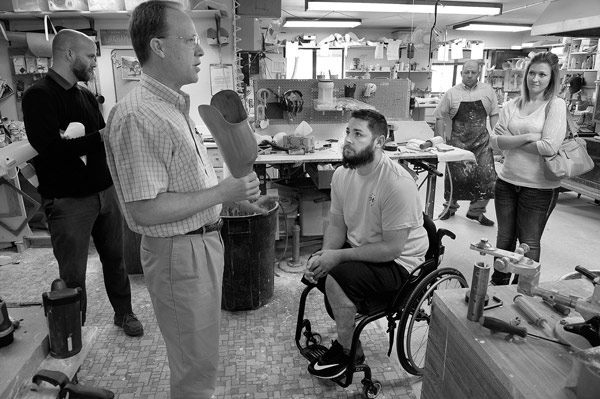The tissue around Jacobs' incision is hard and hurting. The pus seeping from the wound has shifted from slightly pink to sickly yellow.
A month after surgery, his leg is infected.
Jacobs was warned about this before the surgery: A spreading infection could eat away at the healthy tissue above his amputation. If that were to happen, he could lose even more of his leg.
But this, at least, is a familiar foe. In the 22 months he spent recovering at Walter Reed Army Medical Center, he had more infections than he could count. Treated quickly with antibiotics, this should clear up soon.
Two weeks after the infection is brought under control, the outside segment of the wound, an area about the size of the last knuckle of his pinkie, still hasn't closed. VA doctor Alvin Kwok tells Jacobs there's a chance it simply won't.
The surgeons who stitched him up after the operation were working with skin that was badly scarred and, in some places, grafted from other parts of his body. It's not easy to mend skin like that, Kwok says during an appointment in early May.
"I think it will close eventually," the doctor says. "We could probably do surgery, but that would just mean another wound that would have to heal."
Kwok advises Jacobs to wait two weeks to see what happens.
The next stop is physical therapy. In the elevator, Michele rubs her husband's back.
"If surgery can fix it, let's just fix it," he says.
"We don't know if that will be faster," she says. "I know it's hard, but you've got to be patient. Your body isn't used to any of this."
In the six weeks since surgery, Jacobs has come to trust his physical therapist, Bart Gillespie, above all others at the VA hospital. "We'll see what Bart thinks," he says.
Gillespie concurs with Michele. "It looks like it's healing, just slowly. I think we should stay the course."
Jacobs accepts the advice, but he's frustrated and surly.
"This f---ing sucks," he says as Gillespie steps away. "On the way home we're going to go to the gas station so I can get some cigarettes."
"You're not doing that," Michele replies — he hasn't smoked since the surgery. "That's not going to solve anything, and we don't have the money."
"We have money — my money," Jacobs says.
Michele winces. The start-up energy-drink maker where she's typically employed as a bookkeeper hasn't had enough work for her over the past few weeks. They've been living on Jacobs' disability pension and a small stipend she gets from the VA for helping provide for his care.
She takes a deep breath and looks away from her husband. "I'm not taking you to the gas station," she says. "And you can't get there yourself — so there."
"I should have hidden a pack for situations like this."
"You're acting like the world is coming to an end," she says. "Do you really think the world is coming to an end?"
"Yes, it feels like that to me," he says. "This wasn't part of my plan."



